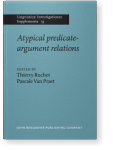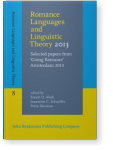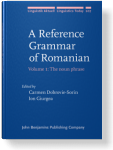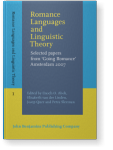Elena Soare
List of John Benjamins publications for which Elena Soare plays a role.
2024 Chapter 7. On the production of subject and object relative clauses by child speakers of heritage Romanian in France Language Acquisition in Romance Languages, Torrens, Vicenç (ed.), pp. 168–196 | Chapter
This study investigates the production of subject and object restrictive relatives in child heritage Romanian in contact with French. The main goal is to evaluate the effect of schooling in the societal language, over a longer period of time, on the acquisition of these complex syntactic… read more
2021 Moving towards an event: The Romanian prepositional supine construction Romance Languages and Linguistic Theory 2017: Selected papers from 'Going Romance' 31, Bucharest, Nicolae, Alexandru and Adina Dragomirescu (eds.), pp. 297–310 | Chapter
This chapter addresses the status of the prepositional supine construction with the locative preposition la “at”, especially as complement of motion verbs. This construction encodes a goal of motion event, and it interestingly admits a continuation in which this event goal is not reached. In… read more
2016 Non-categorical categories: Aspect, Voice, Pred and the category of Participles Atypical predicate-argument relations, Ruchot, Thierry and Pascale Van Praet (eds.), pp. 131–160 | Article
This paper aims at circumscribing the range of structures that underlie participial constructions, with a particular emphasis on Romanian data. Participial constructions exhibit high flexibility, e.g., the participial stem labeled “supine” in Romanian grammars, which can be used in both nominal and… read more
2015 Deverbal nominalization with the ‘Down’-operator Romance Languages and Linguistic Theory 2013: Selected papers from 'Going Romance' Amsterdam 2013, Aboh, Enoch O., Jeannette Schaeffer and Petra Sleeman (eds.), pp. 223–238 | Article
We argue that the nominal supine in Romanian is a nominalization by the definite determiner in its interpretation as a ‘Down’-operator, which correlates with an event-kind denotation. We use as evidence the restricted nominal properties of the nominal supine, which indicate that it does not have a… read more
2013 Chapter 11. Deverbal nouns A Reference Grammar of Romanian: Volume 1: The noun phrase, Dobrovie-Sorin, Carmen and Ion Giurgea (eds.), pp. 663–718 | Article
2013 Chapter 9. Adnominal non-finite constituents and complement clauses A Reference Grammar of Romanian: Volume 1: The noun phrase, Dobrovie-Sorin, Carmen and Ion Giurgea (eds.), pp. 565–596 | Article
2010 Syntactic realizations of plural in Romance and Germanic nominalizations Romance Linguistics 2008: Interactions in Romance, Arregi, Karlos, Zsuzsanna Fagyal, Silvina Montrul and Annie Tremblay (eds.), pp. 107–124 | Article
This paper offers a syntactic account for the various ways in which Plural is expressed within Argument-Supporting Nominals (ASNs) in Romance and Germanic. We first show, starting from Romanian data, that pluralization is connected to aspectual properties like (a)telicity and (un)boundedness. These… read more
2010 Predication and the nature of non-finite relatives in Romance Edges, Heads, and Projections: Interface properties, Di Sciullo, Anna Maria and Virginia Hill (eds.), pp. 191–214 | Article
This paper investigates non-finite verbal constituents that qualify as modal non-finite relatives in Romanian, French, and Italian. We show that these constructions are reduced relatives based on the relativization of the object. The analysis extends to reduced relatives in general, and argues for… read more
2009 Structural patterns blocking plural in Romance nominalizations Romance Languages and Linguistic Theory: Selected papers from ‘Going Romance’ Amsterdam 2007, Aboh, Enoch O., Elisabeth van der Linden, Josep Quer and Petra Sleeman (eds.), pp. 145–160 | Article
Some Complex Event Nominals (CENs) like the Romanian infinitive contradict the generalization in Grimshaw (1990) according to which CENs do not pluralize. But many CENs like the Romanian supine and the Spanish nominal infinitive obey this generalization. In this paper we explain the availability… read more







